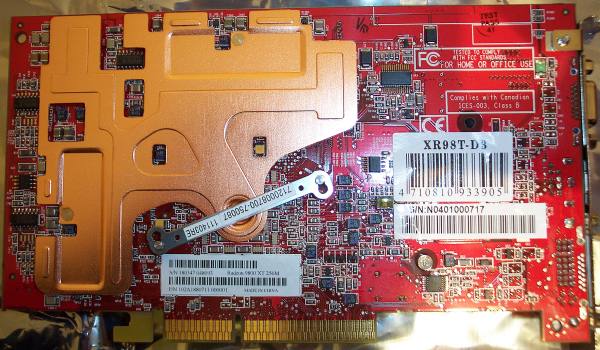Appearance
If you're in need of a quick refresher as to why the 9800XT is reckoned to be the best DX9 3D accelerator, head here. To summarise for the lazy clickers out there, there's been no wholescale changes from the Radeon 9800 Pro to the 9800XT. A bump in engine and memory speeds, a standard 256MB of onboard RAM, and a few under-the-cooler tweaks make an already impressive GPU into a gaming goliath. ATI's DX9 implementation, too, appears to be better than NVIDIA's. In short, it's quite difficult to go wrong with the R360 as a base for cutting-edge graphics.
The above picture isn't just a cut and paste from Ryszard's initial look at the R360, but it sure looks like it. PowerColor has decided that reference safety is the best course of action. Save for a few different component locations, PowerColor's 9800XT is strictly reference. The question remains of whether this is a good or bad move. It can be argued from both fronts, really. Sticking to a reference design should ensure flawless GPU compatibility and stability. The downside is that it is just like any other of the 10 XTs currently doing the reviewing round. Even Hercules submitted in a reference model. This is in marked contrast with NVIDIA cards, where AIB partners are keen to differentiate themselves, usually with fancy cooling and colouring. With respect to the 9800XT, only ASUS has made a concerted effort to be different. Adding in VIVO functionality and a custom cooling solution certainly marks its XT cards out. Sadly for PowerColor, there's no VIVO here. It's good ol' TV-Out.

It should really be called the 9800CE (Copper Edition), shouldn't it?. Wedges of copper help cool the 412MHz engine clock. Remember that ATI has yet to move to a 0.13-micron manufacturing process for the most power-hungry card in its lineup. The PowerColor 9800XT, like every other reference design, is a weighty, solid card. Construction is excellent.

The front shows the need for an auxiliary power supply to quench the hungry GPU's thirst. It's recommended to have a high-quality 300w PSU in a system that'll house a 9800XT, but we've seen tiny Shuttle XPC PCs run the said card without obvious stability problems. The reference cooler uses a ribbed copper approach to maximise the surface cooling area. The GPU fan spins at a modest speed in a 2D environment, and it can raise its RPM when required. Unfortunately, the user has no manual control over it, unlike, say, ASUS' Smart Doctor-controlled fan.

The S-Video connection is a one-way affair and serves as TV-Out, with a maximum resolution of 1024x768. HD15 and DVI connections are common enough. The final word on appearance has to be generic. What disappoints us is that PowerColor hasn't even sought to inscribe its own name on the top of the card.









